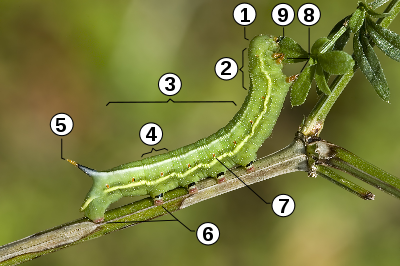Caterpillar (butterfly)



As a caterpillar is called the larvae of butterflies and some other insects (see After caterpillar ).
The caterpillar is the actual feeding stage of the butterfly. For some, this is the only stage at which they eat anything at all. The moths of these species then only live to reproduce and die soon after hatching . Because the caterpillars' body volume increases significantly, they have to shed their skin several times before they have reached their final size. From time to time they form a new, larger skin that grows under the old one. When moulting, the caterpillar swells until the old skin bursts and can be pushed backwards by muscle movements.
features
Similar to other insects with complete metamorphosis , the caterpillars of the butterflies consist of evenly strung together segments that form the trunk. Butterfly caterpillars have 14 segments, the last three of which are usually fused together to form an anal segment. Like the moths, the caterpillars can be divided into the three areas of head, chest and abdomen. The head is usually hardened by chitin deposits . On the underside outside, they usually have six point eyes ( stemmata ) each . The most important characteristic, which also dominates the appearance of the head, is the mouthparts. In contrast to the stubby shaped antennae, they are very pronounced.
Typical morphological features are shown below using the example of the pigeon tail caterpillar ( Macroglossum stellatarum ):
 |
The first three segments form the breast. On each of them a pair of legs is placed, which, like the butterflies, are only shorter. On the back of the first segment there is usually a neck shield made of a plate hardened with chitin. On each side there is a pore-like opening ( stigma ) with which the tracheal system is supplied with oxygen . Such openings are only rarely found on the other breast segments. The following 11 segments form the abdomen, which is not clearly separated from the front part of the body. Each of these segments carries a stigma on breathing. Some of these segments, mostly the sixth to ninth, have limbs, but these are not actually legs, but just undivided skin protuberances that end with wreaths of hooks for better clinging. The so-called belly legs (or belly feet ) are much more domed in shape than the real legs and usually widened like a suction cup at the end. The fourth and fifth segment is in contrast to the very similar larvae of sawflies legless. These only have a leg-free segment. However, several families deviate from this classic caterpillar shape: the primeval moths (Micropterigidae) have provided both of the first abdominal segments with ventral feet, the tensioners (Geometridae) are missing the first three pairs of ventral feet, which have receded and in some owl butterflies (Noctuidae) the first two are missing. The sternum of the snail spiders (Limacodidae) has receded into tiny stumps. All other pairs of legs have also receded, so that the caterpillars crawl like nudibranchs . On the 13th segment there is another pair of belly feet that are much stronger. These are called pushers .
Way of life
The caterpillars mostly lead a hidden life and are also well adapted to their surroundings. They are usually green or brown in color. Caterpillars that live on conifers usually have a longitudinal pattern that makes them seem to disappear between the needles. Animals that are poisonous, such as B. many species of bear moth (Arctiidae), warn predators by conspicuous color. These caterpillars do not hide and show themselves undisturbed on their feeding plants. Other caterpillars that are not poisonous but that have a similar coloration ( mimicry ) benefit from them. But there are families such as B. the bearer moth (Lymantriidae), in which the caterpillars look very unusual. The caterpillars of the swarmers are among the largest in Europe. They can reach a length of 15 centimeters. They usually have two eye patches and can imitate small snakes through their posture . This defense strategy is very effective. In addition, they have such a color that, when they sit upside down on a branch, their contours become so blurred as if they were not as thick as a caterpillar but as flat as a leaf. The sunlit underside is dark and appears as bright as the upper side, which is in the shade. Other caterpillars e.g. B. The spanners (Geometridae) remain motionless with their backs clinging to a branch and look like a branch with their perfectly matched color. They even form bud-like thickenings.
In some species one can observe social behavior. The caterpillars of the processionary moth (Thaumetopoeidae) z. B. live together in large webs and move together in long “processions” to their food sources. This type of camouflage prevents predators from recognizing a single caterpillar.
See also
literature
- Erhard Bodi: The caterpillars of the European butterflies . Sciences Nat, Venette 1985, ISBN 2-85724-029-5 .
- Detlef Bückmann : About the course and the triggering of behavioral changes and discoloration of adult caterpillars. Mainz 1953
Web links
- BUND Rheinland-Pfalz caterpillars of butterflies in Rhineland-Palatinate



